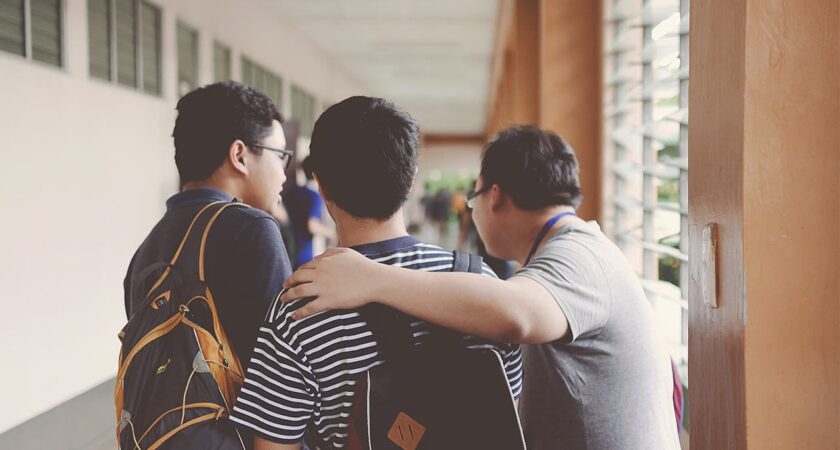The ability to correctly assess the situation and to know the order of actions is very important for every person, and especially for for employees of educational institutions. We ask everyone to familiarize yourself with the actions and evacuation plan for participants in the educational process in case of an emergency situation.
ACTIONS IN CASE OF A TERRORIST ATTACK
Basic measures to prevent a possible terrorist attack:
- Do not touch anything in transportation, residential and public
in transport, residential and public spaces or on the street, do not touch anyone’s packages (bags), do not let others
to them, and do not let others near them. Inform a police officer if you find them; - do not express your discontent in the presence of terrorists,
refrain from sudden movements, shouting and moaning; - If terrorists threaten to use weapons, lie on your stomach,
protecting your head with your hands, as far as possible from windows, glazed doors
passages, stairs; - use every opportunity to escape;
- If an explosion occurs, take measures to prevent
fire and panic, provide first aid to the victims; - try to memorize the signs of suspicious people and report them to
them to the arriving special services.
ACTIONS TO TAKE IN THE EVENT OF A BUILDING OCCUPATION
If you find yourself in a building (premises, territory) captured by terrorists, but have not been found by them.
- remain calm and try to avoid contact with the
with the terrorists; - inform the law enforcement authorities as quietly as possible about the
about the terrorist attack, as well as about your whereabouts; - do not smoke;
- stay away from doors and windows;
- strictly follow the instructions and commands of law enforcement officers;
- hide your documents and business cards.
Remember that immediately after your report
anti-terrorist units will take comprehensive measures
to save your life and health.
EVACUATION FROM THE BUILDING
Evacuation from the building is necessary not only in case of fire, but also in case of
earthquakes, floods and other emergencies, if
the building of the educational institution is dangerous for the people who are there
who are there.
Fire safety rules for educational institutions and facilities
systems stipulate that during evacuation and firefighting
firefighting, it is necessary to
- determine the safest evacuation routes and exits to the
to the safe zone as soon as possible; - eliminate conditions that contribute to panic. To this end, employees of
To this end, employees of institutions and facilities should not leave children
unattended from the moment the fire is detected until it is extinguished; - evacuation of people should start from the room in which the
and adjacent premises that are in danger of
the danger of fire and combustion products spreading. Children
younger children and the sick should be evacuated first; - In winter, at the discretion of the persons conducting the evacuation, children
older children may be dressed in advance or take warm clothes with them.
warm clothes with them, and younger children should be taken out or
or carry them out wrapped in blankets or other warm clothes; - thoroughly check all premises to ensure that children are not
children staying in the danger zone; - set up security posts at the entrances to buildings to
to prevent children and employees from returning to the building where the
the fire has started; - In case of firefighting, the first priority should be to ensure
favorable conditions for the safe evacuation of people; - to prevent the spread of fire and smoke, you should refrain from
from opening windows and doors and from breaking glass.
Evacuation rules for children:
Do not speak – to hear the teacher
Do not run – to avoid getting hurt
Do not push – to avoid getting hurt
Do not turn around – to stay safe
Students are also asked to follow all instructions given by teachers and, if necessary, at the if necessary, at the request of adults, to help other children to evacuate. When you arrive at the safe zone, stay together and stay together with the class.
Evacuation rules for teachers:
- Evacuation is carried out by the appropriate sound signal,
which, if necessary, is activated by the administration or the person who discovered the
the fire. - Remind children of the main purpose of evacuation: their safety and
the rules of evacuation: do not talk. Do not run. Do not push. Do not
turn around. - Close the doors and windows.
- Bring your school emergency kit, a bucket (it may be
folding), and a first aid bag. - Check the safety of the evacuation route.
- During an evacuation, it is recommended to combine two classes and have one teacher lead the
one teacher leads the column, and the other completes the column of children of the two classes.
the column of children from the two classes. - Help children with disabilities and small children.
- Evacuation is carried out to a specific designated place (the place
for each classroom is determined during the training exercise and does not
is determined during training exercises and does not change). - When you arrive at the designated location, check to see if all the children are
children on the list. - Stay with your class and ask students to stay together, to be
the whole class together, and not to go anywhere.
If the hazardous conditions have disappeared, evacuate back to the classrooms following the same
to the classrooms, following the same rules.
